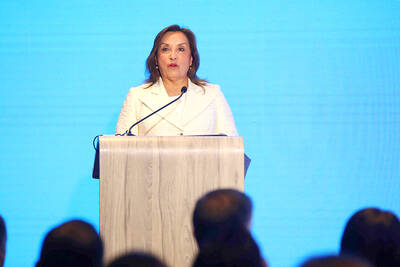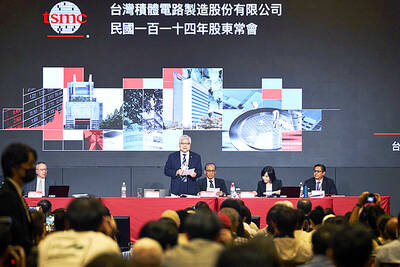Samsung Electronics Co said it intends to sell 2 million light-emitting-diode (LED) TVs this year, bringing the ultra-slim and power-efficient TVs to a 10 percent share of the company’s overall liquid-crystal-display (LCD) TV shipments for this year, a company executive said yesterday.
The figure would be two times higher than the world’s 3 percent average this year, according to the latest forecast by market researcher DisplaySearch released yesterday.
GROWING TREND
The research house said leading LCD TV brands including Samsung, Philips, Sharp and Sony were planning to increase use of LED backlights in the second half of this year as LED backlight’s cost premium over cold-cathode-fluorescent-lamp (CCFL) backlights narrows.
“Our LED TVs have received wide population in the US and Europe. We have sold 400,000 units since they made their debut,” Samsung Electronics Taiwan Co president Smile Kim said yesterday.
The fast uptake has caused supply constraints for some components such as LED chips, Kim said, adding that the company was communicating with Taiwanese companies to increase supply.
PROJECTIONS
For this year, Samsung, the world’s biggest TV maker, said it expects to sell 2 million LED TVs with screen size ranging from 32 inches to 55 inches, Kim said.
In other words, shipments of LED TVs would account for 10 percent of Samsung’s total LCD TV global shipments this year, he said.
That may be an ambitious target, as DisplaySearch forecast that LED TV shipments could grow to 3.6 million units this year.
Next year, global LED TV shipments may increase to 15 million units, making up 10 percent of the global LCD TV shipments, the researcher said.
Separately, Samsung said it aims to expand its local market share to 10 percent by revenues after its new LED TV series hit the Taiwanese market this month, compared to 2 percent in the first three months of the year.
Samsung’s LED TVs will be available at prices ranging from NT$65,900 to NT$179,900 per unit, depending on the screen size and specifications, the company said.

With an approval rating of just two percent, Peruvian President Dina Boluarte might be the world’s most unpopular leader, according to pollsters. Protests greeted her rise to power 29 months ago, and have marked her entire term — joined by assorted scandals, investigations, controversies and a surge in gang violence. The 63-year-old is the target of a dozen probes, including for her alleged failure to declare gifts of luxury jewels and watches, a scandal inevitably dubbed “Rolexgate.” She is also under the microscope for a two-week undeclared absence for nose surgery — which she insists was medical, not cosmetic — and is

CAUTIOUS RECOVERY: While the manufacturing sector returned to growth amid the US-China trade truce, firms remain wary as uncertainty clouds the outlook, the CIER said The local manufacturing sector returned to expansion last month, as the official purchasing managers’ index (PMI) rose 2.1 points to 51.0, driven by a temporary easing in US-China trade tensions, the Chung-Hua Institution for Economic Research (CIER, 中華經濟研究院) said yesterday. The PMI gauges the health of the manufacturing industry, with readings above 50 indicating expansion and those below 50 signaling contraction. “Firms are not as pessimistic as they were in April, but they remain far from optimistic,” CIER president Lien Hsien-ming (連賢明) said at a news conference. The full impact of US tariff decisions is unlikely to become clear until later this month

GROWING CONCERN: Some senior Trump administration officials opposed the UAE expansion over fears that another TSMC project could jeopardize its US investment Taiwan Semiconductor Manufacturing Co (TSMC, 台積電) is evaluating building an advanced production facility in the United Arab Emirates (UAE) and has discussed the possibility with officials in US President Donald Trump’s administration, people familiar with the matter said, in a potentially major bet on the Middle East that would only come to fruition with Washington’s approval. The company has had multiple meetings in the past few months with US Special Envoy to the Middle East Steve Witkoff and officials from MGX, an influential investment vehicle overseen by the UAE president’s brother, the people said. The conversations are a continuation of talks that

CHIP DUTIES: TSMC said it voiced its concerns to Washington about tariffs, telling the US commerce department that it wants ‘fair treatment’ to protect its competitiveness Taiwan Semiconductor Manufacturing Co (TSMC, 台積電) yesterday reiterated robust business prospects for this year as strong artificial intelligence (AI) chip demand from Nvidia Corp and other customers would absorb the impacts of US tariffs. “The impact of tariffs would be indirect, as the custom tax is the importers’ responsibility, not the exporters,” TSMC chairman and chief executive officer C.C. Wei (魏哲家) said at the chipmaker’s annual shareholders’ meeting in Hsinchu City. TSMC’s business could be affected if people become reluctant to buy electronics due to inflated prices, Wei said. In addition, the chipmaker has voiced its concern to the US Department of Commerce